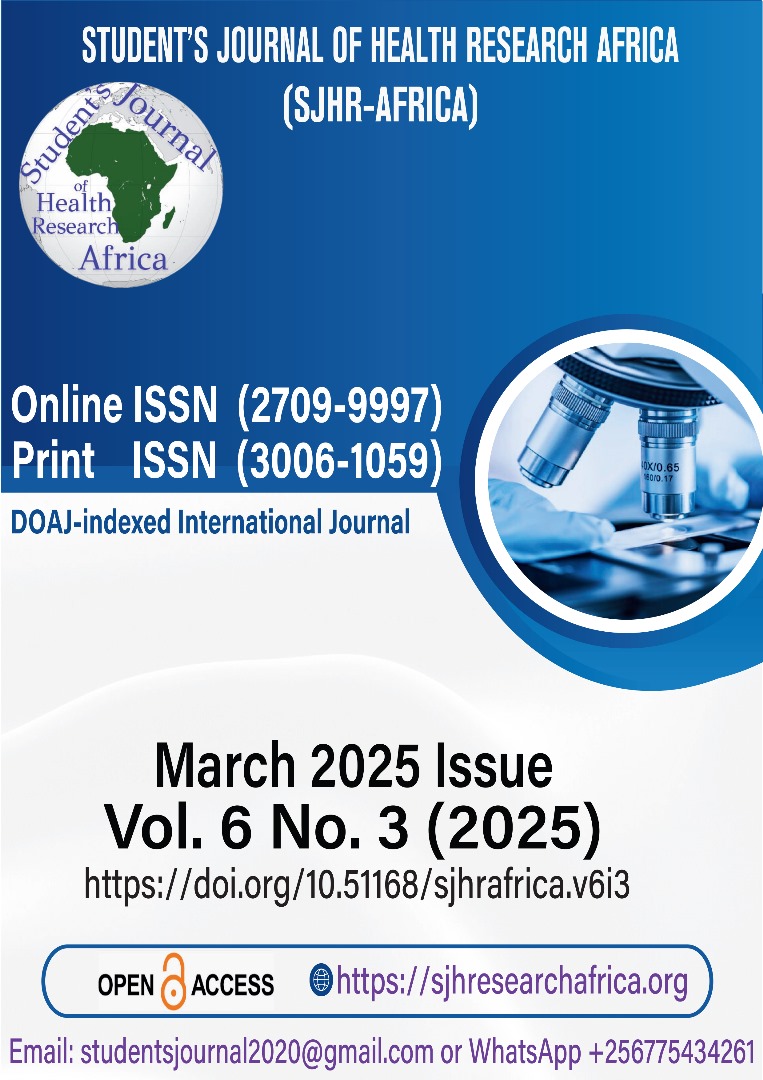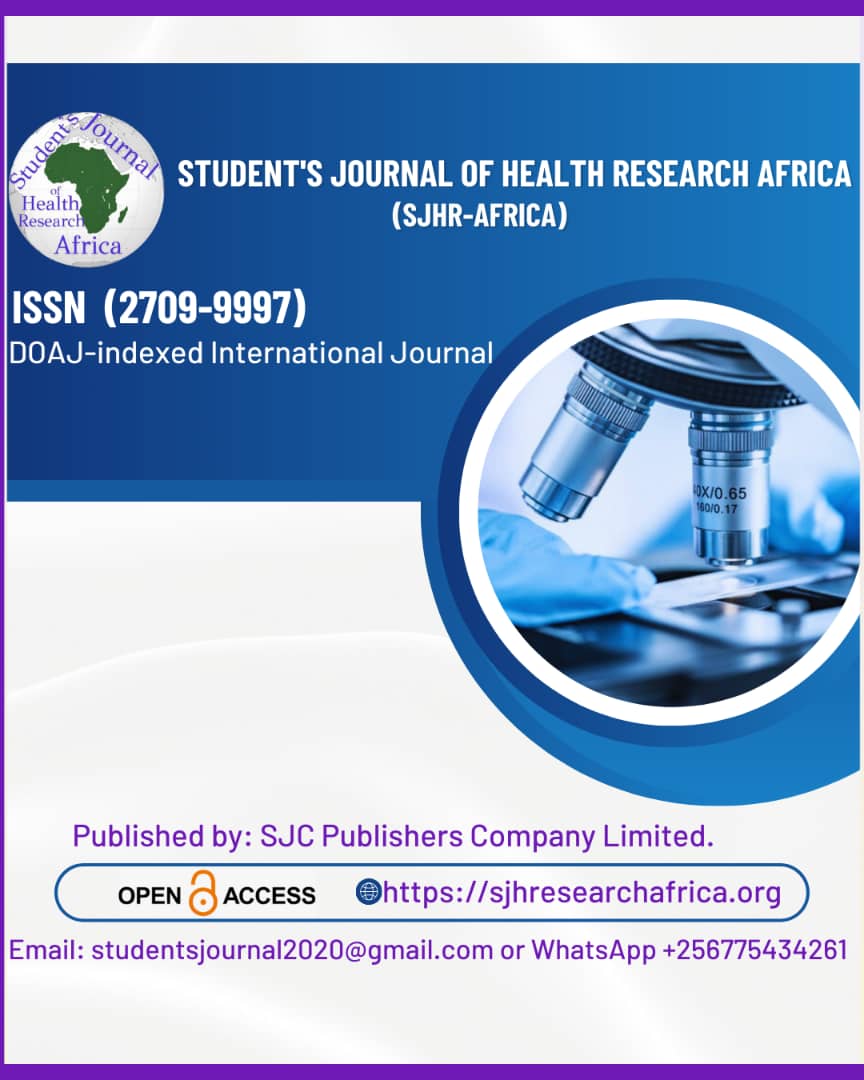AN APPRAISAL OF THE REFERENCE RANGE FOR BLEEDING TIME AMONGST YOUNG NIGERIA ADULTS
DOI:
https://doi.org/10.51168/sjhrafrica.v6i3.1520Keywords:
Bleeding, pregnancy, clinical practice, Nigeria, HemostasisAbstract
Background
This study aims to create baseline values that reflect the distinct physiological traits of this population by evaluating the reference range for bleeding time among young adults in Nigeria. Bleeding time, an important hemostatic characteristic, varies among groups as a result of genetic, environmental, and lifestyle influences. This study seeks to add useful information to the sparse body of knowledge on hemostatic characteristics particular to the Nigerian population by undertaking a thorough examination of bleeding time in a sample of young Nigerian people.
Method
With a cross-sectional design, the study enrolls a varied group of healthy adults between the ages of 18 and 30. Bleeding time measurements are made using standardized procedures, and the outcomes are contrasted with accepted global reference ranges, gender, platelet count, and bleeding time variability.
Results
This study adds to our understanding of hemostasis in various groups and emphasizes the value of individualized reference intervals for diagnostic and therapeutic procedures.
Conclusion
The researcher's conclusions have significance for clinical practice, assisting medical personnel in accurately diagnosing bleeding problems and enhancing patient treatment plans for young adults in Nigeria.
Recommendations
Healthcare institutions and diagnostic laboratories in Nigeria should adopt bleeding time reference ranges that reflect the local population’s physiological characteristics rather than relying solely on international standards.
References
Andrew P. Russeau; Hacen Vall; Biagio Manna. (2024). Bleeding Time. National Library of Medicine. https://www.ncbi.nlm.nih.gov/books/NBK537233/
C.D., E. (2020). Nigerian Journal of Physiological Sciences – Official Publication of the Physiological Society of Nigeria.
Charbek, E. (2020). Bleeding Time. https://emedicine.medscape.com/article/2085022-overview?form=fpf
Charbek, E. (2020). Bleeding Time: Reference Range, Interpretation, Collection and Panels. eMedicine. [online] Available at: https://emedicine.medscape.com/article/2085022-overview.
College of Veterinary Medicine (2019). Bleeding Time Tests. [online] Cornell University College of Veterinary Medicine.
Ezigbo, E.D., Mba, A.I., Yelpoji, P.U. and Okoye, H.C. (2020). Thrombosis Update | Journal | ScienceDirect.com by Elsevier.
Ibrahim, I., Fadel Ali Salem, Heja Abdulsalam Farj, Ibrahim Abdulaati Abdullah, Manal Omar Othman and Mohammed, K. (2019). Duke Bleeding Time in Young Adults at Aljufra University, Libya. asian hematology research journal, 2(3):97-104,2019(AHRJ.52197), pp.1–8.
Kim, Bohyun. “Bleeding Time: Remained or Retired or Removed?” Laboratory Medicine Online, vol. 13, no. 1, 1 Jan. 2023, pp. 1–6, labmedonline.org/journal/view.html?uid=475&vmd=Full, https://doi.org/10.47429/lmo.2023.13.1.1.
Krans, B. (2018). Bleeding Time Test. [online] Healthline. Available at:
Labpedia.net. “Bleeding Time (BT) - Labpedia.net.” Labpedia.net, 25 Jan. 2020, labpedia.net/bleeding-time-bt/.
Maleki A, Roohafza H, Rashidi N, Aliyari F, Ghanavati R, Foroughi S, Nabatchi B, Torkashvand M. Determination of the normal range of bleeding time in rural and urban residents of Borujerd, Iran: A pilot study. ARYA Atheroscler. 2012 Fall;8(3):136-42. PMID: 23358456; PMCID: PMC3557001.
Mount Sinai Health System, Sinai - New York. www.mountsinai.org/health-library/tests/bleeding-time.
Nilsson, I.M., Magnusson, S. and Borchgrevink, C. (1963). The Duke and Ivy Methods for Determination of the Bleeding Time. Thrombosis and Haemostasis, 10(01), pp.223–234. https://doi.org/10.1055/s-0038-1654776.
Nilsson, Inga Marie, et al. “The Duke and Ivy Methods for Determination of the Bleeding Time.” Thrombosis and Haemostasis, vol. 10, no. 01, 1963, pp. 223–234, https://doi.org/10.1055/s-0038-1654776.
Peter von Dadelszen, FRANZCOG, FRCSC. FRCOG. “Bleeding Time | Lab Tests | GLOWM.” Www.glowm.com, www.glowm.com/lab-text/item/12.
Platelet Research Laboratory, Bleeding Time. 2022, Bleeding Time Information | Mount
Porta health at home. “Clotting Factors Test - About, Preparation, Test Results & More | PorteaTM.” Www.portea.com, 2022, www.portea.com/labs/diagnostic-tests/bleeding-time-and-clotting-time-169/.
Portea Medical, 2022. Bleeding Time And Clotting Time Test. https://www.portea.com/labs/diagnostic-tests/bleeding-time-and-clotting-time-169/
Rodgers RP, Levin J. Bleeding time revisited. Blood. 1992; 79: 2495-7. https://doi.org/10.1182/blood.V79.9.2495.bloodjournal7992495. https://doi.org/10.1182/blood.V79.9.2495.2495
Russeau, Andrew P, and Biagio Manna. “Bleeding Time.” Nih.gov, StatPearls Publishing, 2 Jan. 2019, www.ncbi.nlm.nih.gov/books/NBK537233/.
Sakariassen KS, Bolhuis PA, Blomback M, Thorell L, Blomback B, Sixma JJ. Association between bleeding time and platelet adherence to artery subendothelium. ThrombHaemost. 1984; 52: 144-7. https://doi.org/10.1055/s-0038-1661159
Sutor, A. (1998). The Bleeding Time in Pediatrics. Seminars in Thrombosis and Hemostasis, 24(06), pp.531–543. Doi:https://doi.org/10.1055/s-2007-996052.
Tantanate M.D, C. (2013). The bleeding time: a review of basic principles, clinical applications, and laboratory pitfall. [online] Siriraj Med J.
The McGill Physiology Virtual Lab. “Hemostasis - Clotting Time and Bleeding Time Tests.” Www.medicine.mcgill.ca, www.medicine.mcgill.ca/physio/vlab/bloodlab/hemostasis_n.htm.
Downloads
Published
How to Cite
Issue
Section
License
Copyright (c) 2025 Favour C. Uroko, Blessing Ihemelandu Obasi

This work is licensed under a Creative Commons Attribution-NonCommercial-NoDerivatives 4.0 International License.






















